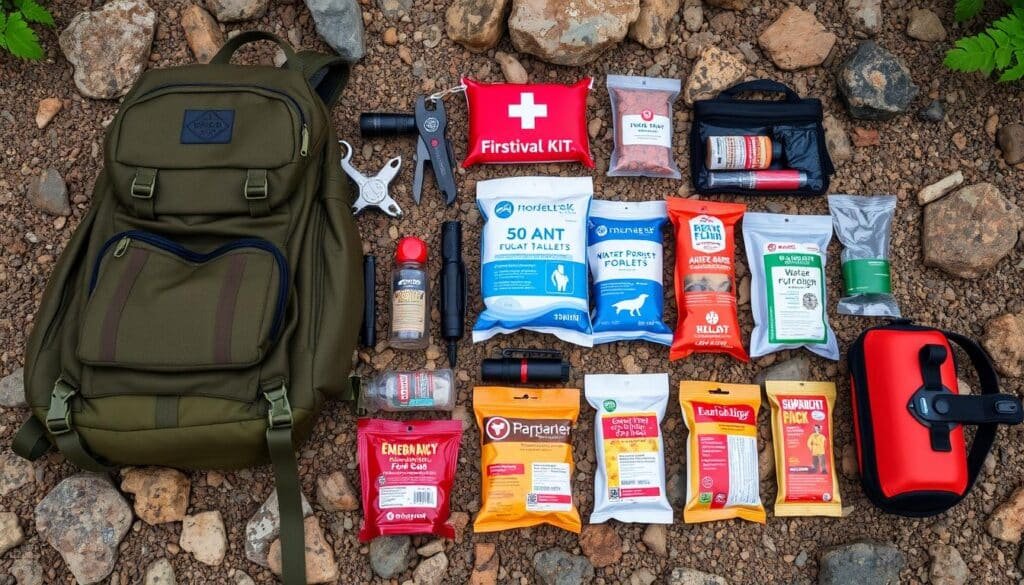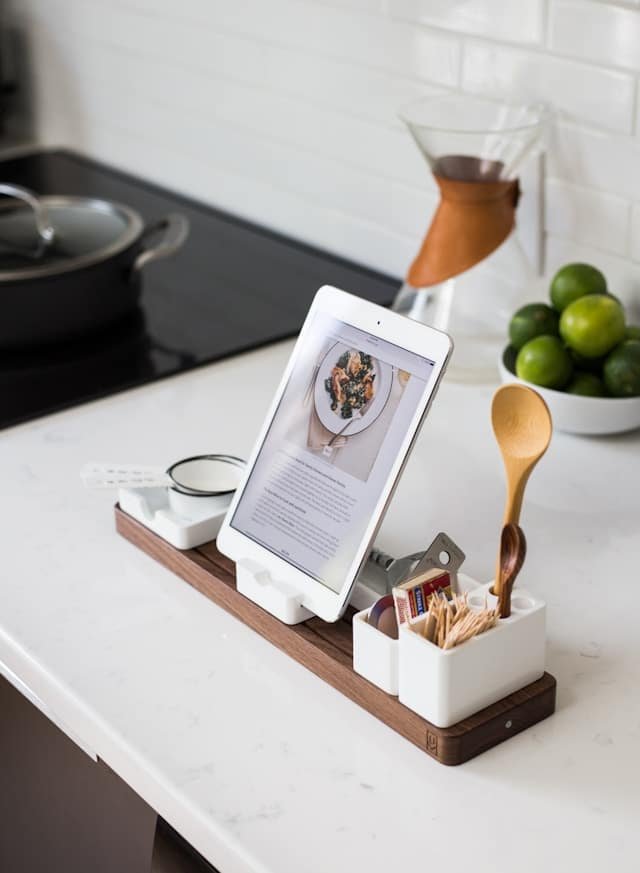Create Your ‘Go Bag’: Be Ready for Emergencies

Having a well-stocked emergency supply kit, or “Go Bag,” is key for disaster preparedness. Natural disasters are becoming more common, making it vital to be ready for emergency evacuation anytime. A “Go Bag” has essential items for survival and comfort during emergencies.
Key Takeaways
- Emergency preparedness is crucial for disaster relief and safety
- A “Go Bag” provides essential items for survival and comfort
- Having a plan in place is key to responding to emergencies and going to emergency evacuation.
- Emergency preparedness kits should be well-stocked and accessible
- Disaster relief efforts can be supported with a “Go Bag” for emergency evacuation.
- Emergency preparedness is essential for individuals and families
Understanding the Critical Need for Emergency Evacuation and Preparedness
Disasters can happen without warning. Having an emergency kit ready helps you evacuate quickly. It also keeps you prepared when you’re away from home for a long time. An evacuation kit is key, providing essential survival supplies after a disaster.
A good evacuation kit has basic needs like food, water, first aid, and communication tools. These supplies are crucial for responding to emergencies and staying safe until help arrives.
The Rising Frequency of Natural Disasters
Natural disasters are happening more often. It’s vital to be ready. Events like hurricanes and wildfires can be very harmful. A well-prepared evacuation kit with the right supplies can save lives.
The Golden Hour of Emergency Response
The first hour after a disaster is crucial. Having a plan can help you act fast and right. This is called the “golden hour” of emergency response. An evacuation kit with essential supplies is very important during this time.
Why Preparation Matters
Being prepared is essential for emergency readiness. An evacuation kit with the right supplies ensures you and your family are ready for anything. It means having a plan, knowing what to do in emergencies, and having the right supplies to stay safe until help comes.
What Makes a Perfect Go Bag
A perfect Go Bag is key for emergencies and disaster relief, especially when a quick emergency evacuation is necessary. It must be easy to carry, light, and packed with essentials for safety and comfort during those critical moments. Think about these important parts when making your Go Bag:
1. Portability and Lightweight Design
- Compact Size: The bag should be large enough to hold essentials but not so bulky that it’s difficult to carry or maneuver with, especially during an emergency evacuation when you might be navigating obstacles or crowds. Consider a backpack or duffel bag style.
- Durable Material: Choose a bag made from water-resistant and tear-resistant material like nylon or canvas to withstand the rigors of an emergency evacuation.
- Comfortable Carry: Look for padded shoulder straps, adjustable sternum straps, and a hip belt (for larger bags) to distribute weight evenly, crucial when you might be carrying your Go Bag for an extended period during an emergency evacuation.
- Lightweight: Every ounce counts when you’re in an emergency evacuation situation. Opt for lightweight materials and pack strategically to minimize weight.
2. Organized Compartments
- Multiple Compartments: Having separate sections for different categories of items (first aid, food, tools, etc.) makes it easier to find what you need quickly, which is essential in the stress of an emergency evacuation.
- Easy Access Pockets: Exterior pockets allow you to grab essential items like a flashlight or multi-tool without having to rummage through the entire bag, crucial when every second counts during an emergency evacuation.
- Waterproof Bags: Use waterproof bags or pouches to protect important documents, electronics, and medications from moisture, ensuring their usability even if your Go Bag is exposed to the elements during an emergency evacuation.
3. Essential Supplies
- Water and Hydration:
- Bottled water (at least 1 gallon per person per day)
- Water purification tablets or a filter
- Hydration powders or electrolyte tablets
- Non-Perishable Food:
- Energy bars
- Dried fruit and nuts
- Canned goods (with a can opener)
- Ready-to-eat meals
- First Aid Supplies:
- Comprehensive first aid kit with bandages, antiseptic wipes, pain relievers, etc.
- Any personal medications
- Communication Devices:
- Fully charged cell phone with a portable charger
- Whistle
- Hand-cranked weather radio
- Other Essential Gear:
- Flashlight with extra batteries
- Multi-tool or Swiss Army knife
- Emergency blanket
- Rain poncho
- Copies of important documents (ID, insurance, medical records) in a waterproof bag
- Small amount of cash
4. Regular Maintenance
- Check Expiration Dates: Regularly check the expiration dates on food, water, medications, and batteries to ensure your Go Bag is always ready for an emergency evacuation.
- Replenish Supplies: Replace any used items immediately to maintain the readiness of your Go Bag for any future emergency evacuation.
- Practice with Your Bag: Familiarize yourself with the contents and location of items in your Go Bag so you can quickly access what you need during an emergency evacuation.
Here’s what we recommend for the minimum amount of water, food and first-aid kit your go bag should contain:
| Item | Importance | Quantity |
|---|---|---|
| Water | High | At least 1 liter per person |
| Non-perishable food | Medium | At least 1 day’s supply |
| First aid kit | High | 1 per person |
Essential Components for Emergency Evacuation
Having a well-stocked “Go Bag” is key for emergency evacuation that’s likely to last longer than a day. It should have water, food, and first aid supplies. These items can help you survive for at least three days in an emergency.
It’s vital to have clean drinking water in an emergency. Store at least three days’ worth of water in your “Go Bag” or include a water filter or purification tablets. Also, pack non-perishable food like energy bars, canned goods, and dried fruits.
Water and Hydration Solutions
Some options for water and hydration solutions include:
- Storing at least three days’ worth of water
- Including a water filtration system
- Adding purification tablets
Non-perishable Food Items
Include non-perishable food items in your “Go Bag”. We recommend the following:
- energy bars
- dried fruit
- canned goods
- ready to eat meals
- fruits and vegetables that last long in the cupboard, such as apples, citrus fruits, celery, and cabbages
First Aid Supplies
A first aid kit is a must in your “Go Bag”. It offers basic medical care in an emergency. Include bandages, antiseptic wipes, and pain relievers.
By packing these essential items in your “Go Bag”, you’re ready for at least three days in an emergency. This ensures you have the survival supplies you need.
Choosing the Right Storage Solution
Having a well-organized evacuation kit is key for emergency preparedness. The right storage can greatly affect your kit’s portability and ease of access. A backpack is a top choice because it’s easy to carry and organize your essentials. Look for one with many compartments, pockets, and a strong build that can handle different weather.
When picking a storage solution, think about durability, water resistance, and comfort. A good backpack should stand up to the weather and keep your stuff dry. It’s also important to find one with padded straps and a comfy design for long carrying times.
Here are some tips for choosing a storage solution for your evacuation kit:
- Consider the size and weight of the backpack
- Look for multiple compartments and pockets to keep items organized
- Choose a backpack with a sturdy design and water-resistant material
Choosing the right storage for your evacuation kit means you’re ready for emergencies. Pack important items like food, water, and first aid. Make sure your backpack is easy to grab in an emergency. With the right storage, you’ll feel prepared for anything.
Documentation and Communication Essentials
Having the right tools for emergency response and disaster relief is key. In a disaster, you’ll need important papers like ID, insurance, and birth certificates. These help prove who you are and get you the help you need.
A “Go Bag” should have copies of these documents and emergency contact info. Keep this in a waterproof place or on a digital device. Also, add a two-way radio for staying in touch with others.
For communication, pack a cell phone, two-way radio, and a whistle. These help you stay connected and signal for help. With these items, you’re ready for any emergency and can help with disaster relief.
Important Papers and Documents
- Identification (driver’s license, passport, etc.)
- Insurance policies (health, home, auto, etc.)
- Birth certificates
- Emergency contact information
Emergency Contact Information
Include contacts for:
- Family members
- Friends
- Emergency services (police, fire, ambulance, etc.)
Communication Devices
Don’t forget to pack:
- Cell phone with charger
- Two-way radio
- Whistle or other signaling device
Survival Tools and Equipment
Having the right survival tools and equipment in your “Go Bag” can make a big difference in emergency situations, like emergency evacuation. These survival supplies help you stay safe and comfortable until help comes. Key items include flashlights, batteries, and warm clothes.
A flashlight or headlamp gives light when the power goes out. A warm blanket or emergency bivvy sack keeps you warm in cold weather. A multi-tool or pocket knife is useful for many tasks. Here are more important survival supplies to think about:
- First aid kit
- Fire starting equipment, such as matches or a lighter
- Water purification tablets or filter
- Non-perishable food items
- Emergency shelter, such as a tent or tarp
Make sure to check your survival supplies often to see if they work and aren’t expired. Tailor your “Go Bag” to your needs and your family’s. With these essential survival tools and equipment, you and your loved ones can stay safe during emergency evacuation situations.

Personal Care and Hygiene Items
Having personal care and hygiene items in your “Go Bag” is key for emergency preparedness. They help keep you healthy and comfortable during emergencies. These items might seem small, but they’re crucial for your well-being.
Basic hygiene supplies like toothbrushes, toothpaste, and soap prevent illnesses. Medical necessities such as prescription drugs and bandages are also vital. They help treat injuries or conditions. Comfort items like blankets and pillows offer emotional support during tough times.
Basic Hygiene Supplies
- Toothbrushes and toothpaste
- Soap and toilet paper
- Shampoo and conditioner
Medical Necessities
- Prescription medications
- Bandages and band-aids
- Antibiotic ointment
By adding these items to your “Go Bag”, you and your family can stay healthy and comfortable in emergencies. This is a critical part of disaster relief and emergency preparedness.
Special Considerations for Different Family Members
When getting ready for an emergency evacuation, think about what each family member needs. This includes children, pets, and the elderly. It’s important to make sure everyone has the right survival supplies to stay safe and comfortable.
For families with babies, don’t forget diapers, formula, and baby wipes. Pet owners should pack food, water, and any needed medicine for their pets. The elderly might need extra medical gear, like oxygen tanks or walkers.
Here are some important items to include in your emergency evacuation plan:
- Childcare essentials, such as diapers and formula
- Pet supplies, including food, water, and medication
- Medical equipment and supplies for elderly or disabled family members
By considering these special needs, you can make sure your family is ready for any emergency evacuation. You’ll have the right survival supplies to keep everyone safe and healthy.
Remember, preparation is key to staying safe during an emergency. By considering the unique needs of all family members, you can create a comprehensive emergency evacuation plan that includes all the necessary survival supplies.
Weather-Specific Items and Seasonal Updates
Having a well-prepared “Go Bag” is key for emergency response and disaster relief. It’s important to include items for different weather conditions and seasons in your bag.
Throughout the year, various emergencies can happen. Each one might need specific items in your “Go Bag.” For instance, in summer, you’ll need sunscreen, insect repellent, and a hat to protect against the sun and bugs.
Summer Emergency Essentials
- Sunscreen with high SPF
- Insect repellent
- Lightweight and light-colored clothing
- Hydration pack or water bottle
Winter Storm Preparations
In winter, your “Go Bag” should have warm clothes, a blanket, and a flashlight. These items help keep you warm and safe during storms. They’re crucial for emergency response and disaster relief.

By adding weather-specific and seasonal items to your “Go Bag,” you’ll be more ready for emergencies. This helps in providing effective disaster relief.
Financial and Identity Protection During Evacuation
It’s key to have a plan for keeping your money and identity safe when you have to leave quickly. Make sure your “Go Bag” has cash and important papers like insurance and ID. Knowing what survival supplies you need is also crucial for your financial and personal safety.
Having emergency cash is a must in case of an evacuation. It can help with unexpected costs like food, shelter, and travel. Also, think about protecting your digital identity with secure devices and online storage to keep your personal and financial info safe.
Emergency Cash Reserves
Having cash in your “Go Bag” is important for the first steps of an evacuation. This can include:
- Cash for food and water
- Cash for transportation
- Cash for shelter and lodging
Digital Identity Protection
To keep your digital identity safe during an evacuation, consider these steps:
- Password-protect your devices
- Use secure online storage for sensitive documents
- Keep your software and operating systems up to date
By adding these key items to your “Go Bag,” you’ll be ready for an emergency. You’ll have the survival supplies you need to protect your money and identity.
| Item | Importance |
|---|---|
| Cash | High |
| Identification | High |
| Insurance policies | Medium |
| Digital identity protection | High |
Location and Accessibility of Your Go Bag
Having your “Go Bag” in a spot you can quickly grab is key for emergency preparedness. This lets you act fast in emergencies, helping with disaster relief. Pick a place like a closet or a special area that’s easy to get to and safe from damage.
Think about how big and heavy your “Go Bag” should be. It should be light enough to carry easily. Also, make sure it meets the needs of everyone in your family, like kids, pets, and people with disabilities. This way, your plan covers everyone, making it more effective.
When picking a spot for your “Go Bag,” consider a few things:
- Is it close to exits and escape routes?
- Is it safe from dangers like floods or falling things?
- Is it easy for everyone in your family to get to?
Choosing a good spot for your “Go Bag” helps you and your family be ready for emergencies. This way, you can get help quickly when disasters happen.
Being ready for emergencies is crucial for staying safe. With a well-prepared “Go Bag” in a good spot, you and your family can stay safe. This also helps in responding better to disaster relief efforts and emergency evacuation.
| Location Considerations | Importance |
|---|---|
| Proximity to exits | High |
| Protection from hazards | High |
| Accessibility for all family members | High |
Your Emergency Readiness Action Plan
Creating a detailed emergency plan is crucial for your family’s safety in crises. It should include important details like emergency numbers, a meeting spot, and evacuation drills. Make sure everyone in your family is involved in planning and that you update the plan often.
Practicing your plan is essential. Hold drills with your family to know what to do in emergencies. This reduces panic and boosts teamwork. A good emergency response plan is vital when time is of the essence, especially when you have to do an emergency evacuation.
Having the right survival supplies and a practiced plan gives you peace of mind. Stay alert, informed, and prepared. Your family’s safety is worth every effort.
FAQ
What is a “Go Bag” and why is it important for emergency preparedness?
A “Go Bag” is a vital emergency kit with key items for disasters. It ensures your safety and survival in unexpected events. Having one ready can be a lifesaver.
What are the most critical components to include in a “Go Bag”?
Key items for a “Go Bag” are water, non-perishable food, first aid, and important documents. Don’t forget communication devices and survival tools. Customize it for your family’s needs.
How do I choose the right storage solution for my “Go Bag”?
A backpack is perfect for a “Go Bag” because it’s easy to carry and organize. Choose one with many compartments and pockets. It should also be durable for all weather.
What special considerations should I make for different family members in my “Go Bag”?
Think about the unique needs of family members like children, pets, and the elderly. Include diapers, formula, pet food, and medical supplies as needed.
How do I ensure my “Go Bag” is readily accessible in an emergency?
Keep your “Go Bag” in a spot that’s easy to reach, like a closet. Make sure it’s not too big or heavy. This way, you can grab it quickly in an emergency evacuation.
What is the importance of having an emergency readiness action plan?
An emergency plan is crucial for your family’s safety. It should list emergency contacts, a meeting spot, and practice drills. This ensures everyone knows what to do in an emergency.





One Comment
Comments are closed.